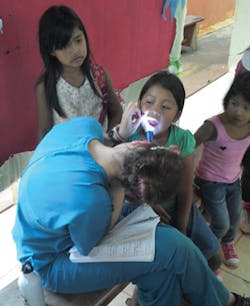Tribal tribulation: An investigation into dental caries in third-world conditionsTribal tribulation
An investigation into dental caries in third-world conditions
By Courtney Mather, BSDH
Background: A tribe of Indians near Aquidauana, Brazil, was examined applying the DMFT and DMFS indexes.
Methods: Data was recorded utilizing the DMFT (decayed, missing [extracted due to caries], and filled teeth, and the DMFS (decayed, missing [extracted due to caries], and filled surfaces) indexes. Observations were made through visual means, utilizing natural sunlight and a small flashlight. Translators were consulted regarding diet, homecare, and professional treatment.
Results: Of the 83 children examined, 100% had caries with a mean DMFT score of 11.7 and a mean DMFS score of 23.6. The percent of teeth affected by decay ranged from 10% to 85%. The percent of surfaces affected by decay ranged from 2% to 63%. Forty-three (52%) students had ≥25% decayed surfaces and 48 (58%) students had ≥50% of total (counted) teeth with decay present.
Conclusions: Dental caries are incredibly prevalent in this population of young tribal Indians. Without any dentifrices, fluoride treatments, or regular preventive checkups with dental professionals, the condition of these tribal members is not likely to improve in the future.
Introduction: What would you do if every student in your child's class had untreated dental decay? What if access to toothpaste and fluoridated water was out of the question? What would you do?
----------------------------------------------------------------------
Consider reading these articles too
- The business of public health dental hygiene endorsement
- Infection Control and Volunteer Dental Settings
- Dental Impact continues to coach on outreach efforts
----------------------------------------------------------------------
This is the reality tribes face every day in many parts of the world. A local church in Michigan took a group of college-aged students down to Aquidauana, Brazil, in May 2013. For a week, the group carried out sporting activities, crafts, and Bible lessons with the children of a tribe that live about an hour outside the city.
As a dental hygienist, natural instinct and curiosity took over. I transported hundreds of toothbrushes, floss, and toothpaste to distribute. Before acting as Santa to dispense gifts, I embodied the tooth fairy giving presentations before hundreds of students in classrooms. My interest continued when I decided to survey in what condition I might find their dentitions. With a small sample of 83 children and interviewing teachers about life in the tribe, I gained valuable insight into dental life in third-world conditions.
Objectives: To calculate and present the prevalence of dental caries in a group of 83 children to determine what condition the average dentition of a child would be with no exposure to fluoride or preventive treatment.
Methods: Data was recorded utilizing the DMFT and the DMFS indexes. Due to children possessing mixed dentition, only the primary teeth were evaluated.1 The figures conveyed in the primary dentition are five surfaces for a posterior tooth (buccal, lingual, mesial, distal, and occlusal) and four surfaces for anterior teeth (facial, lingual, mesial, and distal). The total count is 88 surfaces.2
Observation was made through visual means, utlizing natural sunlight and a small flashlight.
Results: Of the 83 children examined, 100% had caries with a mean DMFT score of 11.7 and a mean DMFS score of 23.6. The smallest percent of teeth affected by decay was 10%. This, unfortunately, means there were two decayed teeth in this child, which was the saddening minimum quantity for a community. The highest percent of surfaces affected by decay was 63% on a six-year-old boy. Fifty-five surfaces and 13 (of the 20 counted) teeth in his mouth were rotting.
Of the 83 students, 43 (52%) students had ≥25% decayed surfaces and 48 (58%) students had ≥50% of total (counted) teeth with decay present. The highest number of teeth with caries was 13 in a five-year-old male child. Without PPE or other intraoral aids, I was unable to displace the cheeks to note any abscesses. Comparing surface decay percentages by gender, there was no significant difference between the two. The boys had 41% and the girls 43%. According to this sample, six-year-olds had the highest surface decay at 28.6%. The disease severity is undeniable, but untreated decay is not considered a crime of neglect in this part of the world. Only 17 children had any restorations. Twenty percent had seen treatment and were still, by no means, infection free.
Discussion: This study discloses a high caries involvement in children of this tribe. I sat down with a translator and a few teachers from the schools to find insight into habits that affect the dental health of the tribal children. Their normal diet consists of rice, eggs, vegetables, fruits, bread, milk, butter, salami, beef, chicken, juice, and soda.
Mixed answers came to the inquiry: "Do the children ever complain of toothaches?" One teacher never encountered the situation. Others stated the students do not complain specifically to the teachers because they know the teachers do not have the materials to help, and another stated the teachers do not care. This may appear harsh; however, with no resources to help the children, the instructors tire of hearing a problem they have no means to solve.
During my presentation, the children stated they brush their teeth on multiple occasions throughout the day. I asked the teachers, assuming the hearsay is true, why do these children still have so many cavities? One felt it was the lack of incentives and education, one thought it was the lack of other home aids (such as toothpaste), and another said they eat sweet foods.
There is no dentist in their tribe, but once a month a dentist comes to do fillings. The treatment, though, is only for the children who have employed parents. No preventive care is discussed, demonstrated, or executed in this remote area. The teachers indicated that the children eat sweets, which in combination with inferior or absent preventative methods, explains the rampant decay.
Conclusion: Results reveal that dental caries are incredibly prevalent in this young population. Without any dentifrices, fluoride treatments, or regular preventive checkups with dental professionals, the condition of these tribal members is not likely to improve in the future.
The Egyptians as early as 5000 BC created a powder to clean teeth that consisted of powdered ashes of ox hooves, myrrh, powdered and burnt eggshells, and pumice.3 These were natural ingredients found in their immediate surroundings.
This indicates there is, perhaps, a natural knowledge to clean the oral cavity and demonstrates how modern marvels have humble beginnings. Perhaps given the knowledge of what their natural resources can provide, dental health can make small advances in this and other tribes over time with the correct resources. As a profession, we should strive for more outreach programs and sponsorship to various countries to make fighting dental decay a global effort.
Courtney Mather, BSDH, graduated in 2012 from Ferris State University with a bachelor's in dental hygiene, where she concluded the program with a trip to New Zealand to complete her capstone project. Courtney is a member of the ADHA and serves as the public relations chair of the Michigan DHA's Macomb component. She will be joining the United States Air Force and leaves for training in 2014, serving as a dental hygienist. Courtney currently works in private practice in Pleasant Ridge, Mich.
References
1. Wilkins EM. Clinical Practice of the Dental Hygienist. 10th ed. Portland: Lippincott Williams & Wilkins, 2008.
2. Cappelli DP, Mobley CC. Prevention in Clinical Oral Health Care. Philadelphia, Pa: Mosby Elsevier; 2007.
3. The History of Toothpaste and Toothbrushes. bbc.co.uk. Retrieved on August 19, 2013.









